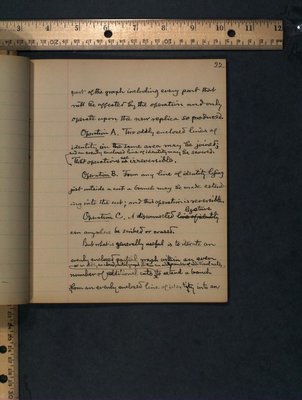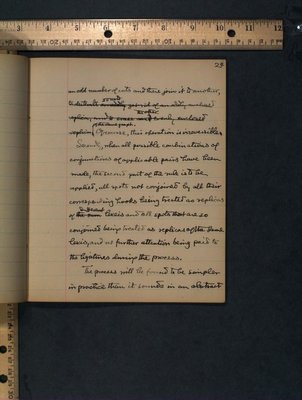Pages
11
16
17 lemmas, and 27 corollaries. There are also 2 scholia. At the same time, I ought to remark that, while the possible conclusions are innumerable, yet after all premises have been iterated so as to exhaust all the different ways of using them together with all simpler ways, there will be no more theorems of any particular interest, and the branch of mathematics in question may be said to be substantially exhausted. The theory of conics is an instance. The great geometer Charles after he attained to a great age continued to grind out, by the bushel basket full, such theorems as that in a plane, the number of conics that touch five given conics is 3264. I think that when a mathematical theory has nothing new to discover but such propositions as that it may be said to be,
12
18
exhauster. Every given mathmatical theory must, in that sense, eventually become exhausted. Whether or not new theories of interest will continue to offer new problems or not, I am not prepared to say.
But to come back to the matter in hand, I give you without further preface, the following rule for positively, ascertaining whether or not a given graph is beta possible.
In the first place find in the graph every lexis, (regarding θ as a lexis), of which one replica is oddly enclosed that it is within an odd number of cuts) and another evenly enclosed [???} within an even number of cuts the latter not being enclosed by every cut that encloses the former; and call every such pair of spots an adaptible pair. Having found such an adaptible pair An adaptible pair is said to be conjoined
13
when, and only when, every hook of ne of its spots is joined by a ligature to the corresponding hook of the other spot, Your object will be as far as [feasible?] to [loare?] no adaptible pair [unconjoined?], and if this be impossible, at any rate, to produce every possible combination of [con-junctions?] in some replica of an evenly [enelarged?] part of the graph, unless you see sclearly that a given combination would not serve your purpose in any degree. In oder to do this you are permitted to perform only of the following operations upon [figatures?]provided that before performing a non-reversible operation you iterate an evenly ended
14
22
part of the graph including every part that will be affected by the operation and only operate upon the new replica so produced.
Operation A. Two oddly enclosed lines of identity in the same area may be joined; and an evenly enclosed line of identity may be severed. These operations are irreversible.
Operation B. From any line of identity lying just outside a cut a branch may be made extending into the cut; and this operation is reversible.
Operation C. A disconnected ligature can anywhere be scribed or erased.
But what is generally useful is to iterate an evenly enclosed partial graph within an even number of additional cuts or an [???], enclosed partial graph within an odd number of additional cuts, to extend a branch from an evenly enclosed line of identity into an
15
24
an odd number of cuts and there join it to another, of the same graph. Of course, this operation is irreversible.
Secondly, when all possible combinations of conjunctions of applicable pairs have been made, the second part of the rule is to be applied, all spots not conjoined by all their corresponding hooks being treated as replicas of different [lexeis?] and all spots that are so conjoined being treated as replicas of the same lexis, and no further attention being paid to the ligatures during the process.
The process will be found to be simpler in practice than it sounds in an abstract




